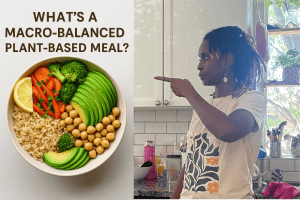
What This Post Is About
Let’s end the confusion about protein on a vegan diet.
In this post, we’ll break down how much you really need for fat loss, what science says, what experts like Jeremy Ethier, Dr. Fuhrman, Leif Arnesen, and Nimai Delgado recommend, and how to build balanced, high-protein vegan meals without living just on protein powder.
By the end, you’ll know your daily target and feel clear, confident, and capable of hitting it consistently.
If you’ve ever wondered how protein for weight loss vegan actually works:
“Do I actually need more protein to lose weight?”
“How much is too much?”
“Can I get enough from plants, or do I need powder?”
…you’re not alone. Protein has probably been the most confusing part of vegan weight loss for all of us. Everyone online seems to say something different, from fitness coaches shouting that you need “at least 150 grams” to plant-based doctors saying you’re already getting enough just from beans and greens.
So today, let’s clear it all up, simply and honestly.
We’re going to unpack what science actually says, what leading experts agree on, and what real life looks like when you start tracking your protein on a plant-based diet.
My goal: to help you feel sure about your number and confident about what to eat, no stress, no overwhelm.
If you’re just starting your fat-loss journey, you’ll love my full guide: Vegan Weight Loss: Real Guide for Busy Women, it explains how to create lasting results through smart nutrition, consistency, and self-care.
Why We Need Protein for Vegan Weight Loss
When it comes to protein for weight loss vegan, here’s the truth: if you want to lose fat while keeping your shape or improve it, protein is non-negotiable. Let’s break down the why in four simple points:
1. Protein protects your muscles (and your shape).
When you lose weight, your body burns both fat and muscle for energy. Without enough protein, you risk losing those muscles.
That’s why getting enough helps you avoid the “skinny-fat” look and keeps your body firm and strong.
2. It helps us see results from the gym.
If you’re lifting weights or using resistance bands, protein becomes your recovery tool. It’s what helps muscles repair and define after every workout.
If you consistently hit your protein target, you will notice it: the workouts feel stronger, the recovery faster, and your body composition tighter.
3. It supports metabolism.
Muscle burns more calories than fat, even at rest. The more lean muscle you keep, the more your metabolism stays active, which means your body keeps burning fat even when you’re not working out.
4. It keeps you full (and calm).
Weight loss means eating fewer calories than you burn. Protein helps you stay satisfied and reduces constant hunger or snacking.
It’s the secret to eating less without feeling deprived.
And one more bonus: I have personally noticed better energy and even warmth once my protein intake is consistent. (I used to always feel cold, now I’m the one kicking off the blanket at night!)
The Science: How Much Protein Do You Actually Need?
Understanding how protein for weight loss vegan truly works helps us separate myths from what’s actually proven by research.
Let’s translate the science into something simple in human language.
1. What research says (without the jargon)
Most studies that coaches like Dr. Mike Diamond or Jeremy Ethier summarize come from meta-analyses, which are essentially large studies that combine dozens of smaller studies to reveal the overall truth.
Those analyses show that muscle growth and fat-loss results plateau around 1.6 grams per kg of body weight (≈ 0.7 g per lb). Going much higher doesn’t show more benefit.
For active women, a sweet spot is 0.7–1.0 g per lb (≈ 1.6–2.2 g/kg).
Jeremy Ethier explains: “More isn’t always better. Beyond about 0.8 grams per pound, there’s little to no extra gain in muscle, especially if calories are controlled.” Check his video here in which he explains that.
2. The plant-based perspective
Dr. Fuhrman, author of Eat for Life, says that most people already meet their protein needs through a varied whole-food plant-based diet. He focuses on nutrient density; eating beans, greens, and grains that naturally contain all the amino acids the body needs.
But, and this is important, plant proteins are less efficiently absorbed than animal ones.
The body utilizes approximately 85–90% of the amino acids from animal protein, but roughly 70–80% from plant protein. That’s why vegan experts like Leif Arnesen (Vegan Superhero Academy) and Nimai Delgado often recommend aiming slightly higher on a plant-based diet, just to make sure we’re covered.
Leif Arnesen shares: “When you’re vegan, think of protein as a floor, not a ceiling. Getting a bit more won’t hurt, it gives your body what it needs to recover and build muscle efficiently.”
Nimai Delgado adds: “I stay around 0.9 grams per pound when I’m cutting, enough to fuel my training but still feel great on plants.”
So, if you weigh 129 lb (like me), the ideal range is roughly 90–130 grams per day.
That’s right in line with my actual personal target of about 105 grams per day, which fits my 1,300–1,500 calorie goal and keeps me strong, full, and steady in the gym.
3. Per meal, how much can your body use?
Studies suggest our body can use about 20–30 grams of protein per meal for muscle repair.
More than that? The extra isn’t wasted, but it’s used for energy rather than additional muscle growth.
So, if you eat three main meals, aim for roughly 25–30g each, that’s plenty.
4. Women vs. men: does it differ?
Most protein research is based on male athletes, but women’s needs are not dramatically lower.
Because we generally have less total muscle mass, our absolute number is smaller; however, the grams per pound ratio remains similar.
What matters more is consistency, not gender.
So… What’s the Bottom Line?
When we pull together all the expert opinions and science, here’s what we can trust:
✅ For fat loss and strength training on a vegan diet:
0.7–1.0 g of protein per lb of body weight (≈ 1.6–2.2 g/kg)
✅ For each meal:
20–30 g protein spread evenly through the day
✅ For everyday life:
Stay consistent. Whether your number is 90 g or 110 g, hitting it daily matters more than perfection.
If you want your exact number based on your age, activity, and goals, my PowerPlant Boss AI calculator will do it in seconds, no math, no stress.
👉 Try PowerPlant Boss and discover your personalized vegan macros instantly.

Whole Foods vs Protein Powder: What’s Better?
Whole foods are always the foundation.
They give you not just protein, but fibre, minerals, antioxidants, micro and macro nutrients, everything your body needs to thrive.
Whole-Food Protein Wins Because:
- You get complete nutrition: fibre, iron, and phytonutrients.
- It supports gut health and digestion.
- It teaches you to build balanced plates, not just hit numbers.
Protein Powder Helps Because:
- It’s convenient: perfect when life gets busy, you’re travelling, or post-workout.
- It’s efficient: a scoop adds 20–25 g instantly.
- It’s digestible: especially pea- or rice-based blends with minimal ingredients.
Think of it like a vitamin; protein powder is a tool, not a replacement.
I usually add one scoop per day in my chocolate overnight oats, and it keeps my breakfast high-protein and satisfying.
Science backs this balanced approach: studies show that combining whole-food protein sources and one daily supplement (like a powder) supports both performance and long-term adherence better than relying on shakes alone.
Best Plant-Based Protein Sources for Weight Loss
Choosing the right sources of protein for weight loss vegan makes all the difference between simply eating healthy and actually seeing body composition change.
| Food | Protein (per 1 cup cooked) | Bonus Nutrients | Why It Helps Fat Loss |
|---|---|---|---|
| Lentils | ~18 g | Iron, folate, fibre | Keeps you full for hours |
| Chickpeas | ~15 g | Fibre, manganese | Great for salads & stews |
| Tofu | ~20 g | Calcium, magnesium | Complete protein, low fat |
| Tempeh | ~30 g | Probiotics, iron | Gut-friendly & dense |
| Edamame | ~17 g | Vitamin K, folate | Easy add omn and snack protein boost |
| Black beans | ~15 g | Fibre, potassium | Supports heart health |
| Soy milk (1 cup) | 7–8 g | Calcium, B12 (fortified) | Simple swap for dairy |
| Chickpea pasta | ~20 g | Iron, fibre | Perfect dinner option |
Sample Meal Ideas (20–30 g protein each)
- Breakfast: Chocolate protein overnight oats with chia & almond milk
- Lunch: Tofu stir-fry with zucchini, carrots, and quinoa
- Snack: Edamame + vegan protein smoothie
- Dinner: Lentil curry with chickpea pasta
These meals come straight from our 7-Day Vegan Meal Plan — designed for busy women who want fat loss without confusion.
👉 Read it here: 7-Day Plant-Based Meal Plan for Fat Loss
And if you love lighter dinner options, check out 5 Low-Calorie Vegan Dinners Under 500 Calories.
How to Build a Fat-Loss Plate That Works
You might have heard different macro ratios: 45/30/25, 40/30/30, or even 80/10/10.
Let’s make sense of it.
Where 45/30/25 Comes From
This ratio (45 % carbs, 30 % protein, 25 % fat) is based on balanced macronutrient distribution from sports-nutrition research for fat loss. It’s flexible, not a rule.
You can read an article on Healthline here about this subject.
For example, my own ratio sits around 47 % carbs, 28 % protein, and 25 % fat — that’s roughly 1,500 calories, 105 g protein, and 42 g fat. It keeps energy high, hormones balanced, and cravings low.
Other well-known vegan athletes, like Robert Cheeke, have tried approaches such as 60/20/20 or even 80/10/10, but these are higher-carb systems. For fat loss and strength definition, most women do best closer to the 45/30/25 zone, moderate carbs, higher protein, moderate fat. And this is the macronutrient ratio I recommend also.
Signs You’re Not Getting Enough Protein
Semantic keyword: vegan muscle recovery and satiety
You might need more protein if you notice:
- Constant hunger or craving snacks after meals
- Fatigue or weak gym performance
- Slow recovery or soreness that lasts for days
- Losing weight but also feeling “softer” instead of toned
- Feeling cold, low energy, or low mood
When you start hitting your protein goals, you’ll notice:
✅ Steadier energy
✅ Less hunger
✅ Faster recovery
✅ Better workouts
✅ That gentle warmth that makes you feel alive again
Real-Life Example: My High-Protein Vegan Day (~105 g per day)
Here’s a real snapshot of what I eat per day for 1,500 calories, 105g of protein, 42g of fat and 175g of carbs.
Breakfast: Chocolate Overnight Oats + 1 scoop protein (~25 g)
Lunch: Tofu stir-fry with veggies + quinoa (~30 g)
Snack: Edamame + protein smoothie (~20 g)
Dinner: Lentil curry with chickpea pasta (~25 g)
Total: ~105 g protein, balanced, satisfying, and easy to prep.
Simplify It – Let AI Handle Your Macros
You don’t need to turn your kitchen into a science lab.
That’s why I built PowerPlant Boss, a free AI vegan meal planner that does the math for you.
Just tell it:
- Your weight & activity level
- Your goal (lose fat, gain muscle, or maintain)
- Your favorite foods
…and it instantly gives you your daily macros, protein target, and a personalized meal plan that fits your taste and time.
👉 Use PowerPlant Boss, and find your perfect protein balance in minutes.
Conclusion
You don’t need perfection, just consistency and awareness.
When you eat enough protein for weight loss vegan, your body gets exactly what it needs to burn fat, be strong, and build results that last.
Remember: this journey isn’t about restriction. It’s about learning to fuel smarter and fall in love with the process.
💚 Ready to see your number?
Let PowerPlant Boss calculate your ideal protein and give you a personalized vegan meal plan today.
FAQ
Q1: Do vegans need more protein than non-vegans?
Yes, slightly. Because plant protein is a bit harder for the body to absorb, aim for about 10–15 % more total grams than a meat-eater would.
Q2: Can I hit my protein target without powder?
Absolutely. Whole-food sources like tofu, lentils, chickpeas… are enough. Powders are just a convenience tool for busy days.
Q3: How many grams per meal is best?
Aim for 20–30 g per meal, the sweet spot your body can use at once.
Q4: Is it safe to eat 100 + grams of protein daily?
For healthy adults, yes. Research shows no harm within normal calorie ranges. Just drink enough water and balance it with veggies and fibre.
Q5: Why do I feel warmer or more energetic when I eat more protein?
Protein has a higher “thermic effect”, your body burns more calories digesting it. That extra heat can literally make you feel warmer!
💚 Next step: Let PowerPlant Boss calculate your perfect protein target and get your free, personalized vegan meal plan today.




